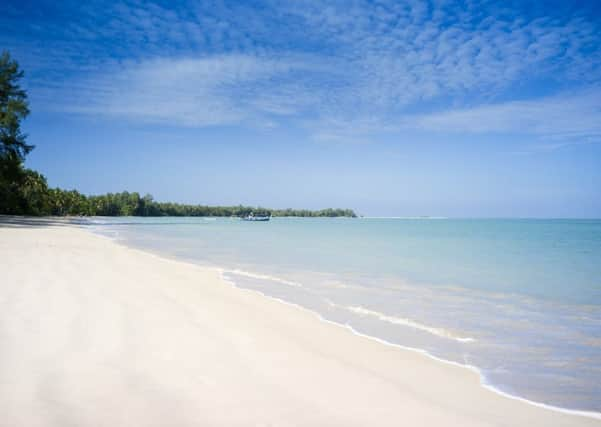Travel review: Unspoilt corners of Thailand


For once the brochure doesn’t lie. Nor do the pictures need airbrushing. There are, it’s true, a host of luxury hotels across Thailand but I wanted to experience those that offered a special authenticity. Hotels with their own story and not merely offering jungle living with wi-fi.
Could, 30 years on, the appeal still be there on an island steeped in mass tourism? Not all of Phuket is now attractive. Garish boards and gaudy buildings, long traffic queues and party-seeking tourists have left their mark. But emerging out of the jungled landscape are some wonderful places to stay. And I want to attempt to do them justice.
Advertisement
Hide AdAdvertisement
Hide AdInitial impressions set the tone, reassure, pamper even. And, my goodness, Thai hotel staff know how to “do” hospitality. When greeting, they hold their hands together in front of their hearts in a prayer-like position and nod their heads. And they simplify matters with wonderfully evocative names such as Mint, Nurse, Nine, Lucky, Touch, Film and Risky.
Nine collected me from the airport. We arrived at Indigo Pearl. It’s a hotel proud of its industrial imagery (with tool-shaped cutlery and propeller fans cooling the patio) reflecting its former role as a tin mine.
The highlight is in the landscaping with a gorgeous infinity pool and shaded avenues of vibrant shrubs and cacti and scented white flowers called champak and leelawadee and the red spiky helicopia.
The next province north of Phuket is Khao Lak, less spoilt and less built-up. Long may that last. The beaches are clean and empty. I stayed at The Sarojin (sarojin.com/en), a stunning boutique hotel. What a joy to be invited to share the passion of the owners’ personal dream.
Advertisement
Hide AdAdvertisement
Hide AdThe vision, created by Sim Boon Yang, a Singaporean architect, reflected the owners’ desire for “a resort that was empathetic to the surroundings and reflected the simple beauty of the site”. The rooms are very Zen, with an “inside-outside” feel. Even the spa is positioned close to the beach in order for the lapping of the sea and birdsongs to be incorporated into the experience.
A few days later I returned to Phuket. Next up was Keemala. Pisit Aongskultong has used sustainable materials for what is a new luxury eco-venture. It has its own distinctive brand, new to Phuket of both fantasy and nature. Resembling the Beijing Olympic stadium, the mesh exteriors of the villas seem suspended in the air. As for the “pool’s nest villa”, it has a bird’s nest theme with round wicker basket beds with grand mosquito nets looking out to sea. The hills and treetops embrace the bird’s nest theme. Each room has its own tree. Frogs are teeming and crickets are chirping. And the Thai language has an expressive vocabulary for their noises! Jiap jiap is the sound of chicks; ake-e-ake-ake of cockerels; gaa gaa of crows and hook hook of owls.
And finally to Amanpuri. I arrived to have a fragrant heart-shaped jasmine bracelet placed on my wrist. Set in a mature coconut plantation and meaning “place of peace”, Amanpuri has real economy of design. While minimal, it’s luxury in an expansive sphere.
Ed Tuttle was the American architect who built upon a former copper mine and opened this flagship Aman hotel in 1988. With 40 pavilions and 44 privately-owned villas, the design is inspired by Thailand’s former capital, Ayuthia. It is built with the woods makha, golden brown with dark veins, and teak.
Advertisement
Hide AdAdvertisement
Hide AdThe design is timeless and serene with intelligent spacing between the restaurants and swimming pool. The sloping location is enhanced with cascading stairs and raised steps that took me down from the rooms to the lobby. Even more magnificently, straight out of a stage setting from Aida, it took me down again from the pool to the private beach.
Everywhere has had the feng shui treatment. The lobby is open-planned, airy, counter-free and welcoming. There’s a nautical feel to the rooms while the wonderful “sala” sun deck smells of sweet varnished teak.
Mosquitoes are present but Deet is good and so I was told is “Marmite and gin and tonic”. Interestingly Trudy Rilling-Collins, an American lady, was brought in by the innovative general manager Paul Linder to minimise the mosquitoes. On researching the pests’ habit of only living within 100-150 yards of steady water for their eggs to hatch, she uses a labour-intensive but highly effective ploy of draining the still waters. It needs constant attention but keeps the customers satisfied. As do the hotel’s airport staff who whisked me through the crowds to take care off the arduous task of returning myself to the world of responsibility.
GETTING THERE
Adam travelled with support from Heathrow Express, Thailand Tourist Board, Exsus Travel (exsus.com) and ICS Travel Group (icstravelgroup.com)
Pearl: indigo-pearl.com
Sarojin: sarojin.com/en
Keemala: keemala.com.
Amanpuri: aman.com/resorts/amanpuri